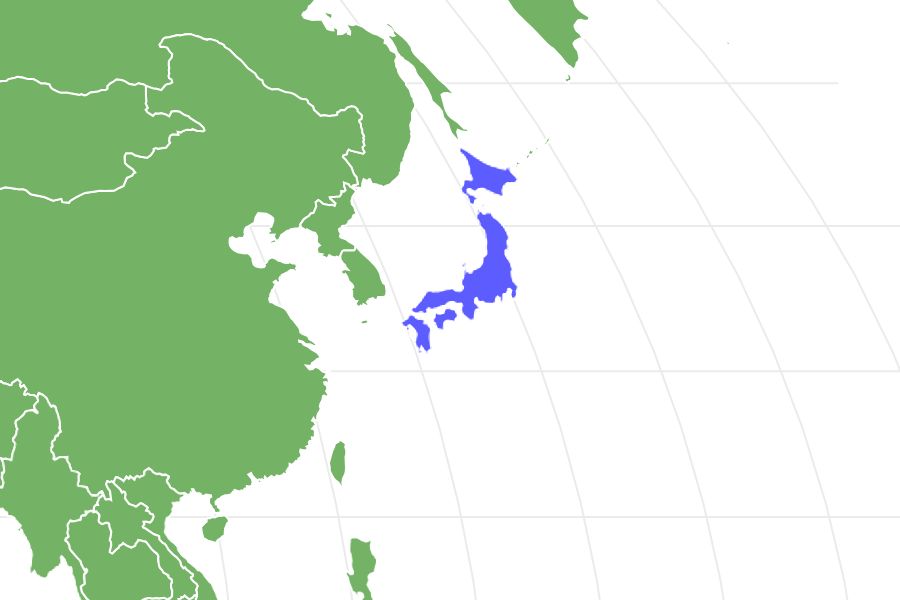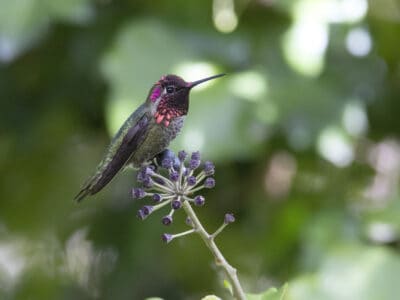Koi Fish
Cyprinus rubrofuscus "koi"
In Japanese, the word koi sounds like the word for love. So the fish is a symbol of love among other good things.
Advertisement
Koi Fish Facts
- Prey
- Aquatic insects and their larvae, crustaceans, worms, its own young
- Group Behavior
- School
- Fun Fact
- In Japanese, the word koi sounds like the word for love. So the fish is a symbol of love among other good things.
- Estimated Population Size
- Hundreds of thousands, at least
- Biggest Threat
- None
- Most Distinctive Feature
- Its beauty
- Other Name(s)
- Nishikigoi, koi carp
- Gestation Period
- Four to seven days
- Optimum pH Level
- 7.0 to 8.5
- Habitat
- Private and public bodies of fresh water
- Predators
- Wading birds such as herons, small mammalian carnivores
- Diet
- Omnivore
- Type
- Fish
- Common Name
- Koi fish
- Number Of Species
- 1
View all of the Koi Fish images!
The Koi is called “The Brocaded Carp”
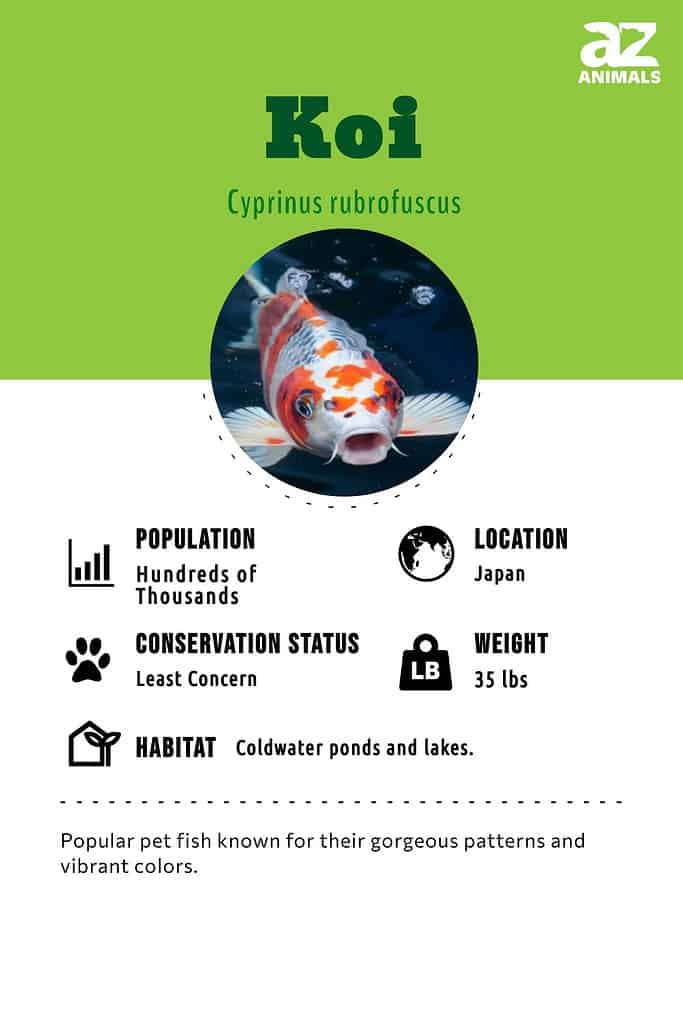
Koi fish have fascinated their owners and brightened their ponds for hundreds of years. People who have some money in the bank aren’t shy about paying great sums for a champion fish of noble lineage. There are 16 main types of koi, each with its own pattern of colors. Read on for more information about these remarkable fish.
See all of our expert product reviews.
5 Incredible Koi Facts!
Here are five facts about koi fish.
- Japanese rice farmers started breeding koi for their beautiful colors in the 19th century.
- Koi have different meanings depending on their coloring. For example, the Ogon koi with its metallic silver scales is a symbol of wealth and a successful business.
- Both goldfish and koi are descended from the carp, a fish whose favorite habitat is a body of standing water with a muddy bottom. Koi have a faster growth rate than goldfish, but the two can interbreed. However, their offspring is sterile.
- The longest-lived koi was a beautiful scarlet fish named Hanako. She was 226 years old when she died, and people could tell because of the rings on her scales indicated her growth rate.
- Koi fish thrive in cool water with a pH level between 7.0 to 8.5. Water with a pH level much below 7.0 or much higher than 8.5 might kill or sicken the fish.
Read more on interesting Koi facts here.
Classification and Scientific Name
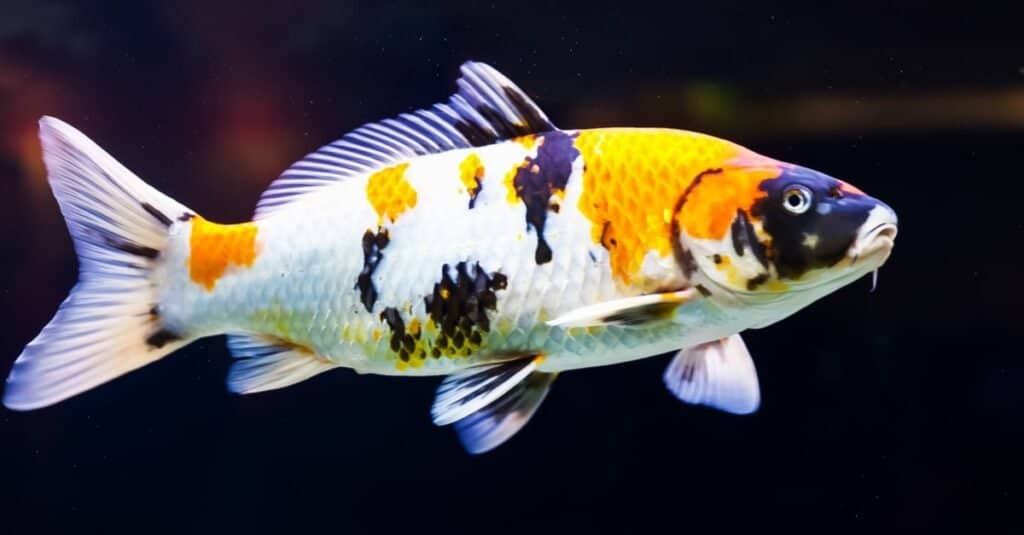
is the koi’s scientific name.
©Wiratchai wansamngam/Shutterstock.com
The scientific name of the koi fish is Cyprinus rubrofuscus “koi.” Cyprinus comes from the Greek kyprínos, whose meaning is “carp,” and rubrofuscus means something like “reddish dark brown” in Latin, which describes the animal’s coloring. So the fish’s scientific name is a “reddish dark brown carp, koi version.”
Health and Entertainment for your Koi Fish
See all of our expert product reviews.
Origin
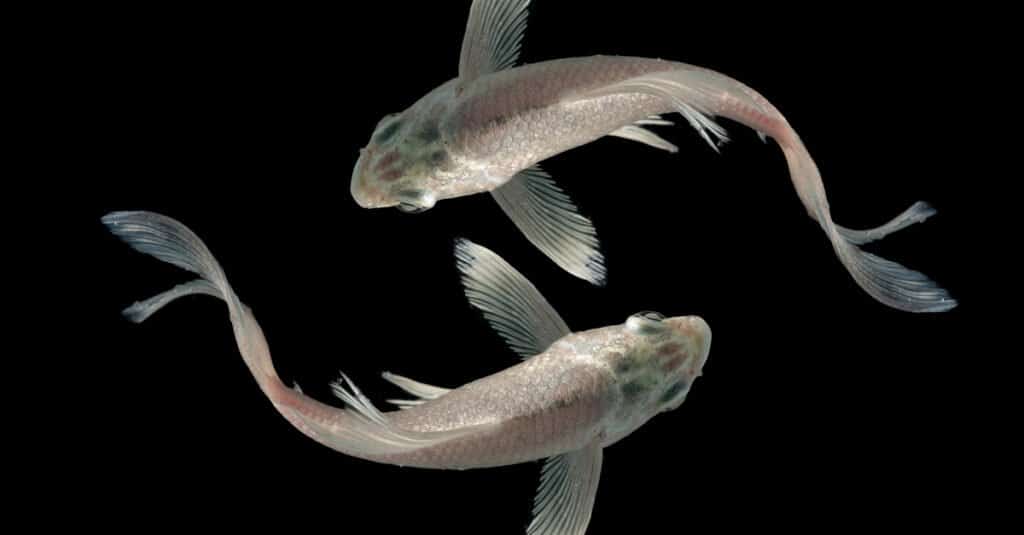
©Dany Kurniawan/Shutterstock.com
Accounts of Japanese emperors possessing prized ponds of brilliantly colored carp appear as early as 720 AD. Concerted efforts to breed these fish and their later classification as koi did not occur until much later, sometime in the early 1800’s. This was achieved by selectively breeding Amur carp who expressed particularly striking patterns. Over the course of the 19th Century, certain varieties became immensely popular and entire subculture surrounding koi breeding arose. This practice is still thriving today and has spread outside of its native Japan to fish enthusiasts around the world.
Appearance
A koi fish should be torpedo-shaped and symmetrical, with no defects in its conformation. It should be plump without being obese, and the paired fins should be the same shape and size. Like all carp, the koi lacks teeth but has a terminal mouth, which means it’s found at the end of its head. Since the fish is largely a bottom feeder, its mouth is inferior, which means it opens downward. Barbs are found at the edges of the mouth, which gives away the koi’s carp ancestry. The colorations of all types of koi fish should be rich and saturated, and white and silver scales should have a sparkle to them.

Koi fish are relatively large at about 35 lbs on average.
©tonirichsag1411/Shutterstock.com
How Much Was the Most Expensive Koi Fish Ever?
The most expensive koi fish ever sold for $1.8 million. It was a female red and white koi fish named S Legend whose owner waited until she was nine years old to sell her. S Legend was 3 feet 3 inches long. She was prized for her perfection of form, her brilliant, perfectly distributed pattern of red and white coloring, and her lineage. She was a Kohaku variety of koi. Kohaku simply means “amber” in Japanese and is the oldest koi type. She was sold to a mysterious Miss Yingying of Taiwan.
Distribution, Population, and Habitat
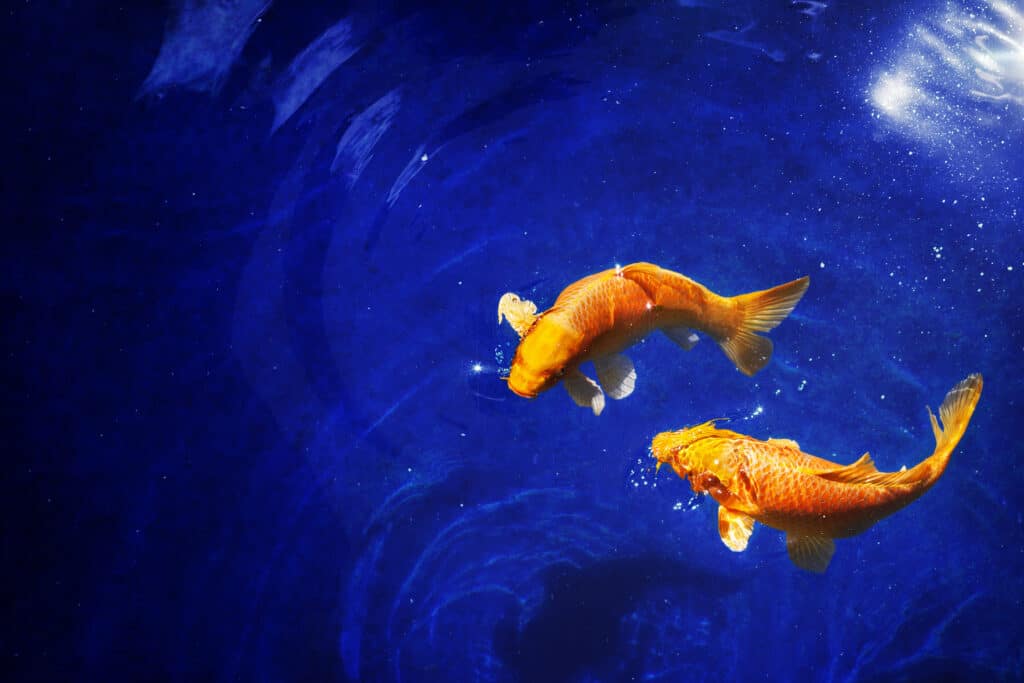
Kois were originally bred in Japan, but they have become popular pet fish worldwide.
©iStock.com/Vera Shestak
People around the world keep koi fish in their water gardens. They are also found in zoos such as the San Diego Zoo, Japanese gardens such as the one at the Brooklyn Botanical Gardens, and even garden centers.
Predators and Prey
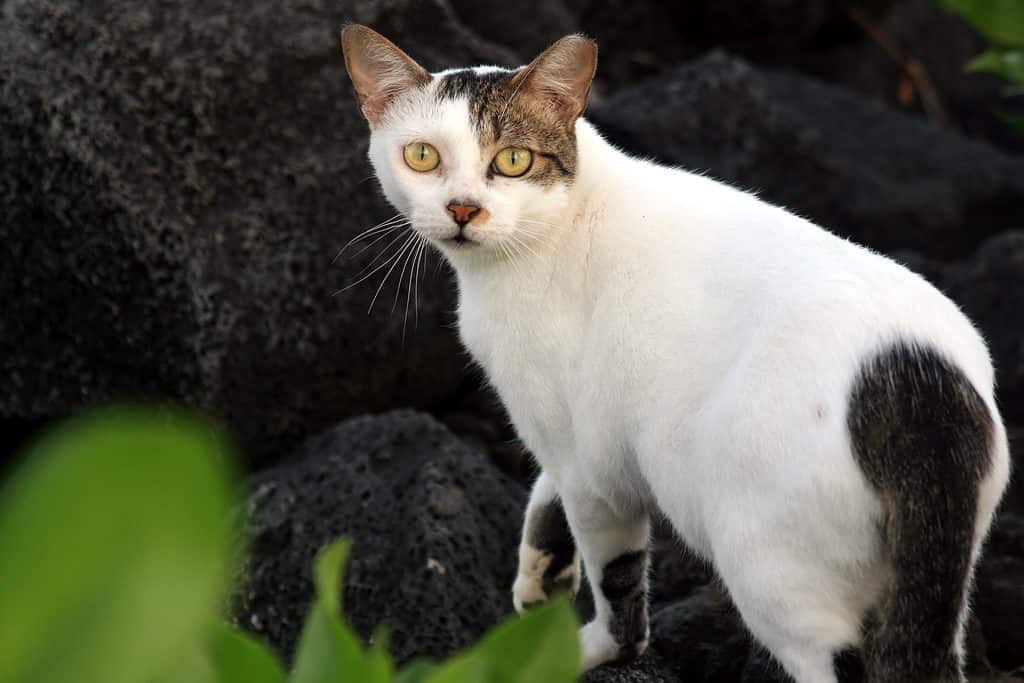
It may not be a good idea to keep kois if you have cats nearby.
©Brocken Inaglory | CC BY-SA – License
Unfortunately, the brilliant coloring of koi fish makes them easy targets for creatures that wish to eat them. These range from wading birds like egrets, storks, and herons to small carnivores such as raccoons, foxes, and cats. This is why it is important for koi owners to maintain a pond that is too deep for a wading bird to stand in. The fish’s habitat shouldn’t have overhangs, such as a low bridge, that a carnivore can use to reach in and grab a fish. It should also be shaded. This not only hides the fish from birds of prey and other predators but protects the koi from sunburn.
Reproduction and Lifespan
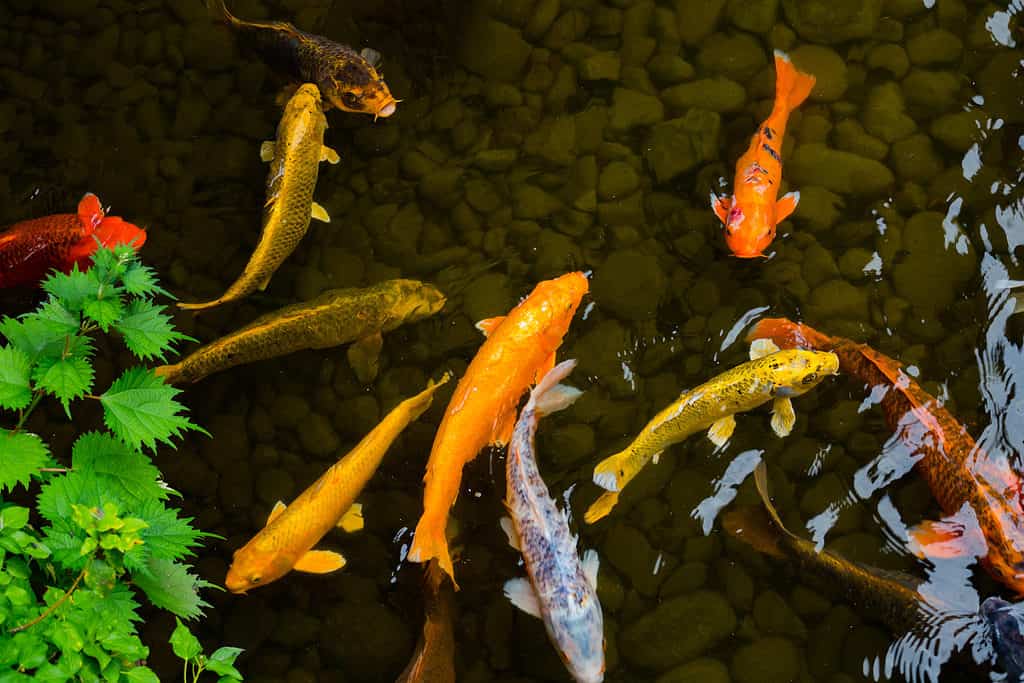
Koi can live hundreds of years if they are properly cared for.
©glory_yabe/Shutterstock.com
Koi fish can enjoy an extraordinarily long lifespan. They can live more than two centuries, but all started life as tiny eggs.
Koi breed in the spring. Males start following females around the pond, and when he catches up to her he nudges her. This causes her to release her eggs, which can number in the thousands. He then fertilizes them. The eggs usually sink to the bottom of the pond, but they will stick to anything they land on.
Unfortunately, about a fifth of the eggs die or haven’t even been fertilized. The lucky ones hatch after about four or five days, but about a fifth of the baby fish die before they’re even an inch long. Some of them are even eaten by adults. At this point, breeders start culling the fish and save only the ones that look promising. The koi has a fast growth rate and might be ready to breed itself when it’s three to five years old.
Koi in Fishing and Cooking
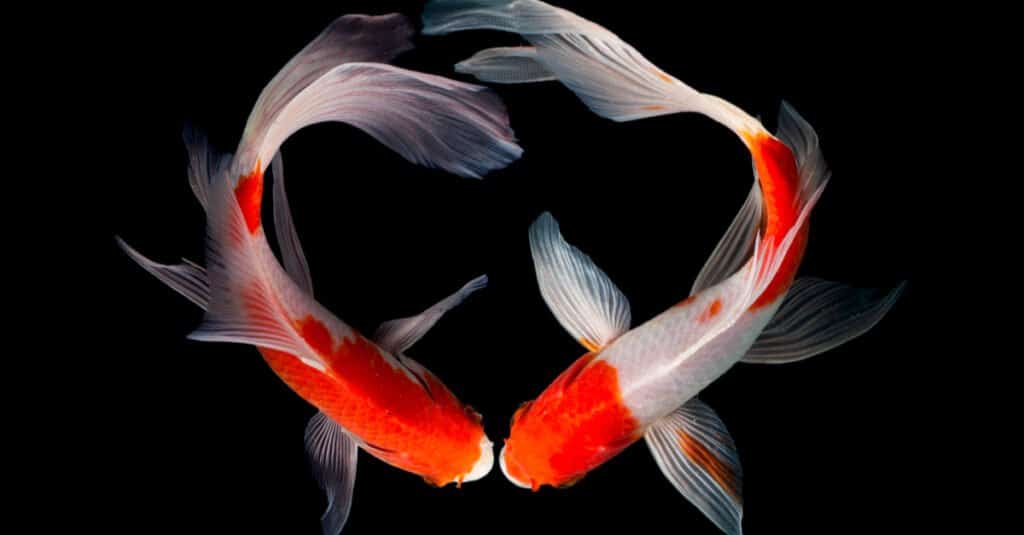
Koi fish are almost never eaten.
©koifish/Shutterstock.com
Koi fish are treasured pets and are not fished, cooked or eaten. Some live for so long that they are passed down as family heirlooms. However, the fish’s ancestor, the Amur carp, was raised for food. The fish started to be bred for ornamental purposes when genetic mutations caused some of the carp to develop patches of color on their scales.
Population
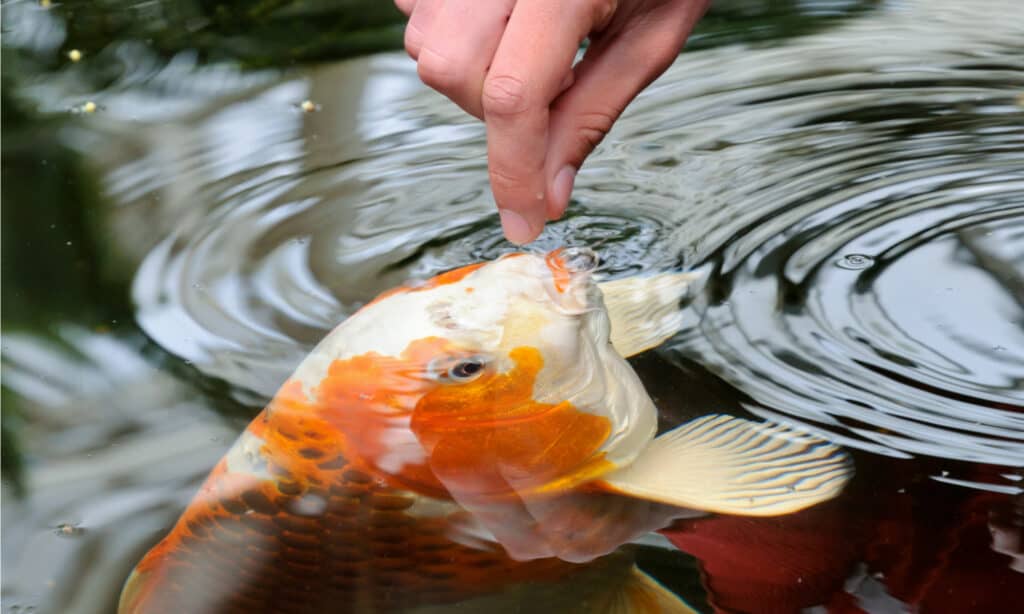
The exact global population of koi is unknown.
©Paul van den Berg/Shutterstock.com
As an ornamental breed, the population of koi is most likely in the hundreds of thousands if not more. It is now raised all over the world.
Types of Koi and Breeding
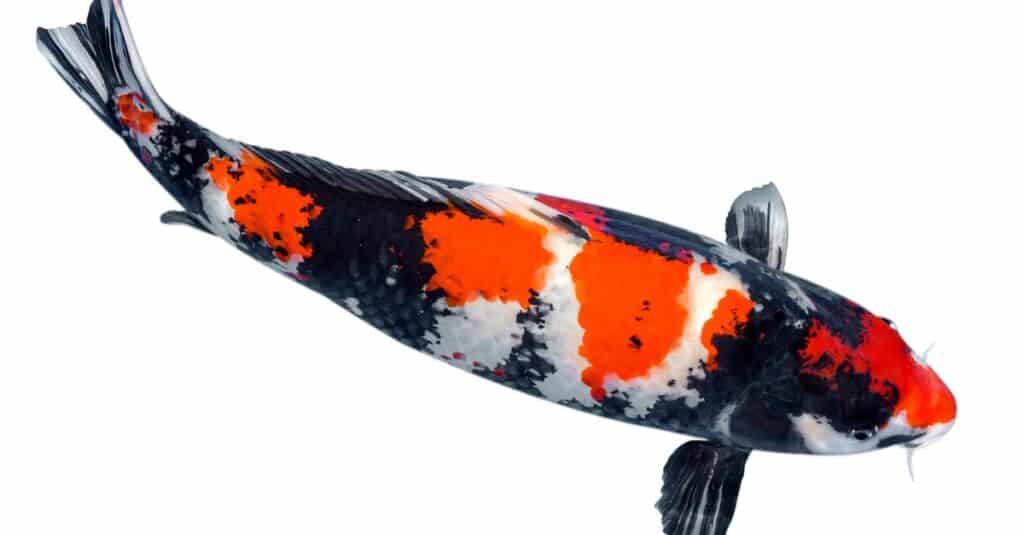
Showa Sanshoku Koi are one of the most popular varieties.
©Phant/Shutterstock.com
While all koi fish are the same species of carp, they have been bred to express certain distinct traits over the course of centuries. Because of this there are 16 recognized groups of koi breeds each with their own gorgeous patterns that set them apart, and dozens of variations of each of these primary categories.
| Kohaku | The first type of koi to be specifically bred, this fish is distinguished by its solid white base and bright red blotches known as hi. |
| Taisho Sanke | These kois are similar to the Kohatsu variety, except they feature small, black speckles in addition to their white base and large red spots. |
| Showa Sanshoku | Kois that are born solid black and later develop large white and red spots. |
| Bekko | Solid red, white, or golden koi with simple, scattered black spots along their back. |
| Hikari-mujimono | Solid colored, shiny, metallic koi with no other markings. |
| Utsuri Mono | These kois have a solid base color and deep, black spots with sharp edges. |
| Asagi | Particularly challenging kois to breed known for their subdued colors and symmetrical, metallic-blue accent scales. |
| Shusui | Scaleless kois with similar coloration to the Asagi variety. |
| Koromo | Translating to “robed,” these fish are a combination of the Asagi and Kohaku kois, and display the gorgeous silver-blue accents of the former and classic, distinguished pattern of the latter. |
| Hikari utsuri | Shiny, metallic koi with deep, dark splotches with crisp edges. |
| Hikari-moyo | Shiny koi with patterns that don’t fall into the previous criteria for Hikari koi. |
| Tancho | Incredibly popular kois that are equally impossible to breed for, distinguished by a prominent red circle on their head reminiscent of Japan’s flag. |
| Kin-gin-rin | Kois that have brilliant, sparkling scales that shimmer in the sunlight. |
| Doitsu | Koi with unique patterns and elegantly ordered scales. |
| Goshiki | Koi which resemble the classic Kohaku variety but with metallic silver or black scales instead of solid white. |
| Kawarimono | All kois not belonging to the aforementioned categories are considered Kawarimono |
Koi Fish FAQs (Frequently Asked Questions)
Where are Koi Found?
Koi are found in bodies of fresh water around the world, but they really got their start in Japan, where farmers started breeding them for their amazing colors.
Why are koi fish so special?
Koi fish are special because of their beauty, which is made by a plump but torpedo-shaped body and rich colors. They are also very long-lived and intelligent. They can recognize the people who feed them and can be trained to eat out of hand.
How much does a koi fish cost?
A high-quality, champion koi fish can cost over $10,000, but the price of an “ordinary” koi fish is between $10 and $380 or more.
Is eating koi fish illegal?
Eating koi is perfectly legal in most places, but people consider their koi pets and may have even paid a great deal of money for them. Not only that, even a carp that is raised for consumption doesn’t taste good.
How long do koi fish live?
Koi fish can live to be over 200 years old, but most live about 25 to 50 years, which is still considerable.
What do koi fish eat?
Koi fish are omnivores, so it is important that their owners give them a balanced diet. They are often fed nutritionally balanced pellets made of fish or blood meal fortified with wheat germ or soybean meal. Treats that koi can be given now and then include fruit such as grapes, strawberries, and watermelon, vegetables such as garlic, cauliflower, and broccoli, bits of bread, cooked rice, hard-boiled eggs, or cooked pasta. Koi should not be fed fish or bugs that the owner caught, corn or peas.
Thank you for reading! Have some feedback for us? Contact the AZ Animals editorial team.
Sources
- Koi Story, Available here: https://koistory.com/blog/koi-fish-treats-what-to-feed-koi-and-what-to-avoid
- Pet MD, Available here: https://www.petmd.com/fish/care/evr_fi_facts-about-koi-fish
- USGS, Available here: https://nas.er.usgs.gov/queries/FactSheet.aspx?SpeciesID=3294
- Smithsonian National Zoo & Conservation Biology Institute, Available here: https://nationalzoo.si.edu/animals/japanese-koi
- Business Insider South Africa, Available here: https://www.businessinsider.co.za/koi-fish-worth-millions-expensive-japan-2018-12?r=US&IR=T
- Unilad, Available here: https://www.unilad.co.uk/animals/worlds-most-expensive-koi-carp-sold-for-record-breaking-1-8-million/
- Koi Health, Available here: http://www.koihealth.info/understanding-ph.html
- San Diego Zoo, Available here: https://animals.sandiegozoo.org/animals/koi
- Brooklyn Botanic Garden, Available here: https://www.bbg.org/collections/gardens/japanese_garden

